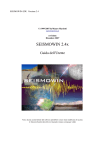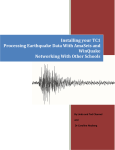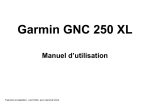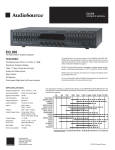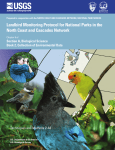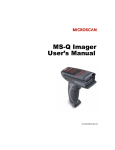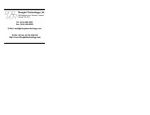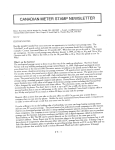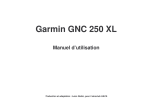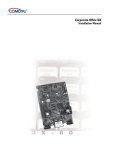Download Chapter 1 - VolksMeter
Transcript
Introduction User’s Manual 1 Introduction The VolksMeter II is a Seismometer / Tiltmeter. It is based on a unique, patented sensor technology that provides low frequency capabilities not found in any other seismometer, at a fraction of the price of conventional broadband force-feedback instruments. The VolksMeter requires a dedicated support computer (Windows XP, 2000 or Vista) to perform data logging, display, analysis and, optionally, networking. The VolksMeter is appropriate for use in geophysical research, education and by the amateur seismologist. Performance/Capabilities ● Detects and measures local and teleseismic earthquakes ● New window on VERY-LOW-FREQUENCY earth motions ● Sensitive Tiltmeter ● Optional GPS-based time standard VolksMeter II with cover removed Powerful, User-Friendly Software ● WinSDR for data acquisition & recording ● WinQuake for display & analysis ● Easily generate TRUE power spectral densities (2Q-2007) Moving Shield Transmitter Plates Receiver Plates VolksMeter Sensor Components VolksMeter II, RS232-C & USB I/O, with cover in place © 2007 RLL Instruments The VolksMeter uses a unique, patented*, Symmetric Differential Capacitor (SDC) array * U.S. Patent Number 5,461,319 1-1 Introduction User’s Manual sensor to detect and measure minute accelerations and tilts. The sensor consists of two fixed printed circuit boards holding the transmitting and receiving capacitor plates and a moving faraday shield array, mounted on the end of a pendulum. When subjected to accelerations or tilts, the shield array on the pendulum moves relative to the fixed plates and changes the amount of receiving plate that is exposed to or shielded from the transmitting plates. This, in turn, changes the overall capacitance of the sensor. A magnetic eddy damper, located below the sensor plates, damps oscillations of the pendulum. A direct Capacitance-To-DigitalConverter (CDC) chip converts the current capacitance of the sensor array to a 24-bit number. An interface board in the VolksMeter controls the CDC chip and formats the acquired data for transmission to the Interface board support computer. 1 or 2 CHANNELS The VolksMeter is available in 1 or 2channel versions. If ordered in the 2channel version, the two sensor arrays are mounted at a 90° angle to each other, and thus can provide useful correlation information or tilt in two dimensions. 2-Channel version 1-2 INTERNAL AIR CURRENTS In order to minimize convective air currents within the VolksMeter case that could cause spurious movement of the sensors, a block of insulating material is mounted above the Interface Board. Thermal Insulation SUPPORT COMPUTER A user-supplied support computer is required to provide control and data logging (at a minimum) for the VolksMeter. A PC running MS Windows XP, Windows 2000 or Vista is required to run the software supplied with the VolksMeter (Windows 95, 98 and ME are reported to work but are not supported). The PC requires a CD-ROM (to load the software) and a USB or RS232-C port (to connect to the VolksMeter). Networking operations require a network interface (usually ethernet) and network connection. Normally, the PC should be dedicated to the VolksMeter, but a multi-tasking system that is capable of accepting a data packet every 200mS from the VolksMeter will work. If the PC is not ready to accept the data packet when the VolksMeter sends it, gaps in the data record will result. INSTALLATION CONSIDERATIONS The VolksMeter may be installed on any hard, flat surface with a good connection to the earth. While an isolated pier is ideal, the VolksMeter performs well on ordinary concrete slabs. For demonstration purposes, hardwood floors and even solidly built tables or lab benches have been used successfully. For best results, the VolksMeter should be protected from air currents, radical temperature changes, and local sources of electrical and mechanical disturbance. After the VolksMeter has been positioned, you must perform leveling by adjusting screws on the Base Plate. Leave room around the © 2007 RLL Instruments User’s Manual Introduction The version of WinSDR that is supplied with the VolksMeter has been specially modified to control and acquire data from the VolksMeter instrument. It supports data resolutions from 16 to 24 bits per sample. One or two channels (with integrated pseudo-channels) may be collected at sample rates from 10 to 80 samples per second. RS232-C and USB connections are supported. WinSDR offers pre-processing of the data in the form of signal averaging, low and high-pass filtering and event triggering. Collected data may be displayed in realtime, either in helicord or single channel formats. Data may be time-stamped precisely using an Typical Installation optional GPS-based time standard (see below). Data may be saved in a variety of formats, including PSN, VolksMeter to access these leveling screws. Because SAC Binary and MiniSeed with Steim 2 encoding. Data files are automatically saved to disk for postof cable length limitations, the support computer must be located within 10 feet of the VolksMeter (a event analysis. Data files may be automatically USB Booster may be used to increase this distance). uploaded to an FTP server. TCP/IP Server/Client The support computer may be controlled and mode and MiniSeed Data Server functions are monitored from a remote location via LAN (typically supported. Data may be sent to the USGS Earthworm Seismic Processing System. ethernet-based) and/or TCP/IP over the Internet using standard remote-access software. WinQUAKE reads the data files output by WinSDR (as well as other sources of seismic data) and ELECTRICAL POWER provides a variety of signal processing, analysis, data display and data conversion functions. These Operation of the VolksMeter requires 9functions include calculating the event distance and magnitude. The frequency spectrum (FFT) of a data 24VDC. A 110VAC set may be calculated and displayed as well as the input power adapter is true Power Spectral Density (PSD). Highpass, included. The VolksMeter may be run on 12V battery power but lowpass, notch and bandpass filtering may be applied to a dataset. Data files may be converted between the support computer must also be powered. An optional upgrade to a universal input (90-264VAC @ Public Seismic Network (PSN), Binary SAC and ASCII formats. There are many other seismic data 47-63 Hz) is available if 110VAC is unavailable. processing functions: See www.seismicnet.com for The part number is VMII-UACA. more information. POWERFUL, USER-FRIENDLY SOFTWARE The software supplied with the VolksMeter consists of two primary components: WinSDR and WinQUAKE. WinSDR provides control, data display, and data storage functions. WinQUAKE provides data analysis, processing and formatting functions. The software package also includes USB drivers, if required. © 2007 RLL Instruments 1-3 Introduction OPTIONAL GPS TIME STANDARD The VolksMeter is equipped to use an optional GPS-derived time standard that provides a clock that is accurate to ±5mS. This is useful in teleseismic research where knowing the precise time of a seismic wave arrival is critical. The GPS unit consists of a GPS Receiver and 16 foot (5m) long RS232-C cable that plugs into the GPS port on the VolksMeter. The cable may be extended if necessary, since the data rate is low. The GPS User’s Manual Comparison of teleseismic response of VolksMeter II to traditional broadband instrument (STS-1). Hawaii earthquake of 15-Oct-06, Mag 6.6 VolksMeter II (integrated) record, Redwood City, CA Optional GPS Time Standard Receiver also provides a precise location (latitude, longitude and altitude) for the VolksMeter (more specifically, the GPS Receiver, which may be positioned some distance from the VolksMeter itself). In the absence of the GPS option, the time stamp for instrument data is derived from the support computer, which may be off by seconds or more, depending on how the computer clock is set. The part number of the GPS clock option is VMIIGPS. PERFORMANCE The figures in the next column compare the integrated (pseudo-velocity) output of a VolksMeter to a broadband STS-1 for the same teleseismic earthquake (Mag 6.6, >3850km from both instruments). The VolksMeter is detecting horizontal motion while the STS-1 is detecting vertical motion. The VolksMeter is somewhat less 1-4 STS-1 record, no filter, USGS Corvalis, OR sensitive to teleseismic events than broadband forcefeedback instruments such as the STS-1 or –2 (150dB vs –180dB), but as the above records show, it can still be effective with a sufficiently strong signal in a low-noise environment. The VolksMeter is superior to all instruments that use velocity sensors in two respects: 1) There is no loss of information associated with position or tilt offsets, and 2) Free earth oscillations. Additional information regarding performance of the VolksMeter II is available at our website: http://www.rllinstruments.com © 2007 RLL Instruments User’s Manual Introduction SPECIFICATIONS Configuration: 1 or 2 horizontal channels, pendulum with Symmetric Differential Capacitive sensors Outputs, Acceleration/Tilt/Time stamp Data Direct digital connection (RS232-C or USB) to support computer Sensitivity, Acceleration: 1 part in 16.7 million across a range of ± 0.0034g Sensitivity, Tilt: 1 part in 16.7 million across a range of ±3.55mRad (±2°) Dynamic Range: >140dB Bandwidth: ~40Hz to DC Natural frequency, f0: 0.92Hz Note: Sensitivity (resolution) is inversely proportional to sample rate. For 40Hz max., a sample rate of 80 samples per second is required. At this sample rate, only 15 bits (1 part in 32,000) resolution is available due to noise considerations, for full 23-bit + sign resolution (1 part in 16.7million) the sample rate must be limited to 10 samples per second or less. At a 10 s/sec rate, the maximum frequency is 5Hz Linearity: Due to the nature of the sensor and the limited travel of the moving plate, the output is inherently linear across the range of motion. Power Requirements: 9-24VDC Note: Current draw is a function of supply voltage and the presence or absence of the GPS option Supply Voltage Current Draw Without GPS Option With GPS Option 9 VDC 45mA 90mA 12 33mA 68mA 15 30mA 54mA 20 22mA 44mA 24 20mA 38mA A 110VAC input, 15VDC/500mA output, power supply is included with the VolksMeter. The usersupplied support computer will have power requirements of its’ own. Environmental Characteristics Operating Temperature: +5°C to +55°C (41°F to 131°F) non-condensing. Storage Temperature: -40°C to +85°C (-40°F to 185°F) non condensing Physical Characteristics Size: 10.75”W x 10.75”D x 19.5”H Net Weight: 23 lbs (2-channel version) Shipping Weight: ~30 lbs (including GPS) SPECIFICATIONS ARE SUBJECT TO CHANGE WITHOUT NOTICE © 2007 RLL Instruments 1-5 Introduction User’s Manual I/O Connector Panel WARRANTY The VolksMeter II is warranted against defects in material or workmanship for a period of one year from the date of purchase. The customer is responsible for returning the product to the factory. RLL Instruments will pay shipping back to the customer for items repaired or replaced under the warranty. CONNECTORS DC POWER: 5.5mm OD x 2.1mm ID center pos. COMM: DE-9S (RS232-C) GPS: DE-9P USB: USB-B(F) INCLUDED WITH STANDARD MODELS VolksMeter II instrument WinSDR / WinQUAKE software on CD-ROM 110VAC Power Adapter Installation Tools RS232-C or USB cable (see above) User’s Manual STANDARD MODELS VMII-1RU Single Channel, RS232-C & USB VMII-2RU Dual Channel, RS232-C & USB (A 10ft USB-A(M) to USB-B(M) cable is normally included with USB models unless otherwise requested) Options: VMII-GPS GPS Time Standard VMII-UACA Universal Input AC Adapter Upgrade Replaces standard 110VAC power adapter. Input: 90-264VAC @ 47-63Hz Includes interchangeable AC plugs. Special Order: VMII-1R Single Channel, RS232-C only VMII-2R Dual Channel, RS232-C only (A 10ft DE-9S to DE-9P cable is included with RS232-C models) SPECIFICATIONS ARE SUBJECT TO CHANGE WITHOUT NOTICE 1-6 © 2007 RLL Instruments User’s Manual © 2007 RLL Instruments Introduction 1-7







